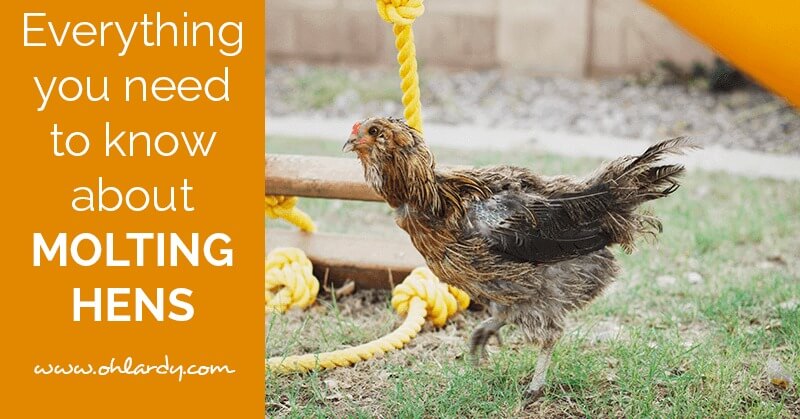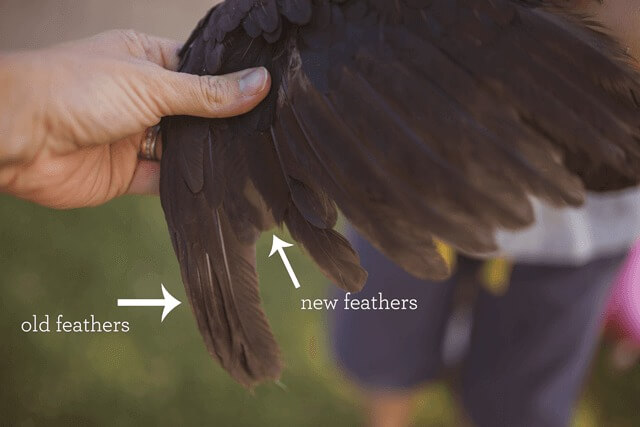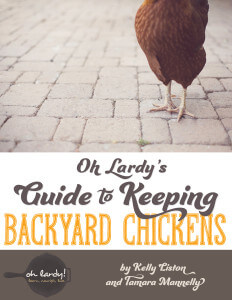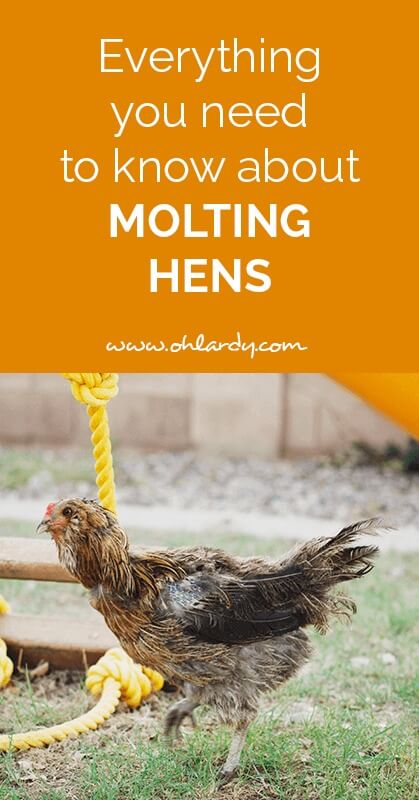Molting Hens – Everything you need to know
Oh Lardy! is a participant in the Amazon Services LLC Associates Program, an affiliate advertising program designed to provide a means for us to earn fees by linking to Amazon.com and affiliated sites.

Not too long ago, I walked into my backyard and it appeared that a coyote had visited – feathers EVERYWHERE. Either a coyote had decimated my entire flock of hens, or the kids had a major pillow fight. Fortunately, all of the hens were alive and well. Turns out they were all starting their yearly molt at the same time. It is as if they are all a bunch of women who live in the same dorm room and their menstrual cycles have synchronized. The major bummer about the seasonal molt is the absence of eggs. If you are new to chicken keeping and your hens are starting to look like mine, I will fill you in on all that you need to know about molting and even what you can do for your hen to help her through it.
Towards the end of summer, my hens all have feathers that look a little dingy and dull. This is the first clue that the girls are getting ready to shed these old feathers in exchange for shiny new ones. Another clue that my hens are going into a molt is that I start to see fewer eggs. And, obviously, the main indicator that my hens are molting is that I start to see feathers everywhere and they start to get real ugly looking. It is best to keep all of your friends who are thinking about keeping chickens away for a few months. You don't want to scare them away with your ugly transitioning hens. That being said, I have one hen who manages to molt without looking ugly like the one above. Not sure how she does it, I guess every hen is different.
So, why does this happen? The feathers on your hen get a lot of use over the course of a year and will start to wear out. The “molt” happens when the hen sheds the old feathers in order to replace them with new ones. The molt, while completely annoying to me, is of particular importance to the laying hen. The molt is the beginning of a rest period for the laying bird and can last for just a few weeks up to a few months. A good laying hen will have a short molt while a poor layer will have an extended molt.
Feathers are about 80% protein and replacing them is a huge task for the bird. She stops laying eggs so that she can put all of her resources towards growing new feathers. During a molt, it wouldn't hurt if you throw a little extra protein at your birds to help them along. In fact, I found a recipe for a “molt meatloaf” that the hens would LOVE and would definitely meet their extra protein needs.
When hens molt, they lose their feathers and grow new ones in a specific order: head, neck, back, breast, stern, thigh, wing, and finally the tail. I have read that observing the growth of the 10 primary flight feathers that are at the end of their wings is a good assessment tool to determine how long the molt will be. Each of these feathers takes 6 weeks to grow back and are typically lost in 2 week intervals. A fast molter will lose the feathers in groups. A slow molter will lose one at a time.
In the image above, you can see where the new feathers have started to grow in and where she still has yet to lose some feathers. It looks like this hen has at least another month before she heads out of her molting phase. What you can't see in the image above is the look on my son's face as he realizes this bird is about to leave his arms no matter what it takes.
So there you have it. A bit of information about molting hens, why they do it, and why it is a bit of a bummer. Keep your chin up, though. They will start laying again and they will be happy with their pretty new feathers.
Did you learn something about molting that you didn't know before? Do you know something that wasn't mentioned that could help a reader? Mention it in the comments!
Would you like some ugly molting hens in your backyard? Don't worry, they get pretty again.
Get Our E-book!
For everything you need to know about chickens, check out Oh Lardy’s Guide to Keeping Backyard Chickens!




What do I use to treat mites on chickens? Would appreciate some help. Lois
They look pretty scary at this time of year. I just about have all of the old feathers cleaned up around here and it’s fun to see the pretty new ones coming in. Funny that people will keep coming by for eggs and give me a funny look when I say “running low on eggs right now, the hens are molting”. even in the countryside people don’t really understand the low production!
Oh, regarding mites, treat them anytime! Get some diotamaceous immediately and clean out the coop, and dust every area especially the roosting bars, corners of the coop and nest boxes. If you’re not familiar with using this, you need to know it is a very fine white powder, almost like corn starch. You’ll need to wear a mask as you put it into places and you can also mix it in with the shavings but a little goes a long way. You also don’t want to use too much because you don’t want it to be too airborne that the chickens breathe it in. It works beautifully and you’ll never want to be without it and you’ll never have to contend with lice again.
I was going to recommend diatomaceous earth as well. Thank you Julie!
Thank you for the article on molting. I didn’t realize egg production slowed down as this was happening. Now I know. Thank you for the very informative info.
Thanks for the info! Our rooster must be moulting because all the feathers around his neck are falling out. Is it the same case of roosters as well? I thought maybe mites but nothing on him and none of the hens are losing anything